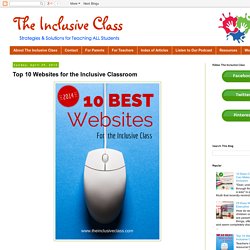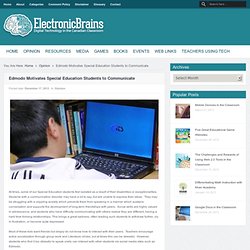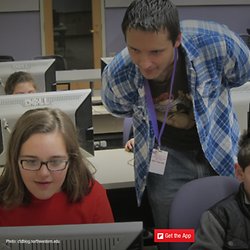

Special Needs Radio sur Twitter : "Sensory accommodations. Sensory-accommodations.jpg (JPEG Image, 1600 × 1236 pixels) - Scaled (64%) The Inclusive Class: Top 10 Websites for the Inclusive Classroom. Teachers love a great resource!

Especially a resource that is free and at their fingertips - literally. That's why I put together a list of 10 outstanding websites that teachers can use in the inclusive classroom (or any classroom, for that matter!). It was difficult to narrow the list down to 10, given all the websites that are available on the internet! However each site listed was chosen for content that I feel is unique or more substantial than what others had to offer. And, finally, these sites are in no particular order. 1. LD OnLine: The world's leading website on learning disabilities and ADHD. Digital Differentiation.
Technology is a tool that can be used to help teachers facilitate learning experiences that address the diverse learning needs of all students and help them develop 21st Century Skills.

At it's most basic level, digital tools can be used to help students find, understand and use information. When combined with student-driven learning experiences fueled by Essential Questions offering flexible learning paths, it can be the ticket to success. Here is a closer look at three components of effectively using technology as a tool for digital differentiation. Note: The interactive graphics you see below have been updated. 50 Useful Apps For Students With Reading Disabilities. Whether you’re the parent of a child with a reading disability or an educator that works with learning disabled students on a daily basis, you’re undoubtedly always looking for new tools to help these bright young kids meet their potential and work through their disability.
While there are numerous technologies out there that can help, perhaps one of the richest is the iPad, which offers dozens of applications designed to meet the needs of learning disabled kids and beginning readers alike. Here, we highlight just a few of the amazing apps out there that can help students with a reading disability improve their skills not only in reading, writing, and spelling, but also get a boost in confidence and learn to see school as a fun, engaging activity, not a struggle.
Helpful Tools These tools are useful for both educators and students with reading disabilities alike, aiding in everything from looking up a correct spelling to reading text out loud. Speak It! Fundamentals Reading Writing. The Myth of Average: Todd Rose at TEDxSonomaCounty. Interesting Graphic on Individualized Learning. Schools learn to outsmart ADHD. When students are diagnosed with attention-deficit/hyperactivity disorder (ADHD), approaches that were once excluded from the classroom are now considered a valid option for helping them focus and learn.

While the most common solution is medication, school district leaders have become increasingly aggressive in using other measures to improve the learning experience. Exercise balls, sensory kits and exercise breaks are among the approaches schools are taking to support students with ADHD as diagnosis of the disorder continues to increase in U.S. schools.
From experimenting with classroom interventions to standardizing administrative procedures, various strategies have earned positive assessments in a number of studies. And while specific steps vary, many of the successful approaches combine behavioral flexibility with efforts to help students focus on academics. Creative accommodations Students may also elect to sit on move-n-sit cushions or Hokki stools, both of which allow movement. The Case Against Assistive Technology. Edmodo Motivates Special Education Students to CommunicateElectronic Brains. At times, some of our Special Education students feel isolated as a result of their disabilities or exceptionalities.

Students with a communication disorder may have a lot to say, but are unable to express their ideas. They may be struggling with a crippling anxiety which prevents them from speaking in a manner which sustains conversation and supports the development of long-term friendships with peers. Social skills are highly valued in adolescence, and students who have difficulty communicating with others realize they are different, having a hard time forming relationships.
This brings a great sadness, often leading such students to withdraw further, cry in frustration, or become quite depressed. Www.edu.gov.on.ca/eng/document/reports/SupportingMinds. Www.peopleforeducation.ca/wp-content/uploads/2014/04/special-education-2014-WEB.pdf. Learning Disabilities Association of Ontario. Www.edu.gov.on.ca/eng/document/reports/speced/panel/speced.pdf. Dabrowski - Dabrowski's Overexcitabilities in Gifted Children. Does your child complain about the seams in his socks? Put her hands over her ears when the movie starts in the movie theater? Have trouble sitting still? Get moved almost to tears by a piece of music or work of art? These are signs of the kinds of intensities that can be seen in gifted children. Polish psychologist Kazimierz Dabrowski identified five of these intensities, which he called "overexcitabilities" or "supersensitivities": Psychomotor, Sensual, Emotional, Intellectual, and Imaginational.
Psychomotor The primary sign of this intensity is a surplus of energy. Rapid speech Impulsive behavior Competitiveness Compulsive talking Compulsive organizing Nervous habits and tics Preference for fast action and sports Physical expression of emotions Sleeplessness Sensual The primary sign of this intensity is a heightened awareness of all five senses: sight, smell, taste, touch, and hearing. Exceptional Learners. Inside.

IEP.